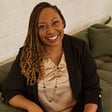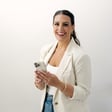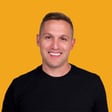Become a Creator today!Start creating today - Share your story with the world!
Start for free
00:00:00
00:00:01

Episode 42: Jessica Jordana - Moving Beyond a Client Profile
Jess and I chat about moving beyond a client profile and actually writing copy designed to convert visitors into clients. I appreciate the practical questions that Jessica outlines in this episode to help people think through the their copywriting.
Jess Jordana is a copywriter (a.k.a. heart-translator) who helps creative business owners turn their passionate mumblings into words people actually "get." She is a 24/7 iced coffee drinker, and firmly believes if date night isn't tacos, you're doing it wrong. She builds her tribe through the motto: "We don't do shallow friendships"; and she wouldn't survive a day in business without her cute husband (Presley) and pup (Joey Tribbiani). You can follow her adventures on Instagram @jessjordana.
Transcript
Creating Viable Sales Leads
00:00:05
Speaker
This statistic is that it takes six to eight touch points to create a viable sales lead, and those are actual touch points. So that means that the message has to actually touch them, and then you have to do it five to seven more times from there.
Introduction to Brands at Book Show
00:00:24
Speaker
Welcome to the Brands at Book Show, where we help creative service-based businesses build their brands and find more clients.
Meet Jessica Drudana
00:00:31
Speaker
I'm your host, Davy Jones.
00:00:36
Speaker
Today's guest is Jessica Drudana, copywriter and brand messaging strategist for creative entrepreneurs. Jess and I chat about moving beyond a client profile to actually writing copy designed to convert visitors into clients. And I really appreciate the practical questions that Jessica outlines in this episode to help people think through the copy that
Listener Engagement Encouraged
00:00:57
Speaker
they're writing.
00:00:57
Speaker
Be sure to check out the show notes at dvandchrista.com for the resources we mentioned during the episode, and I'd like to hear from you about what kind of content you'd like to see on the Brancet Book Podcast as we move forward. I'd also like to know what episodes have you enjoyed most so far and
Copywriting: A Hot Topic
00:01:12
Speaker
why. To leave your feedback, head on over to the Davey and Christa Facebook page and send us a message. Now, onto the episode.
00:01:25
Speaker
All right, Jess, welcome to the brand set book show. Excited to have another copywriter on the show. I have to say that, you know, especially as web designers and brand designers, copywriting is probably one of the most frustrating aspects of building a website for most of our clients. So I'm excited to dig into this episode for tips that we can take back to our clients for sure. And I know it's just one of those, it's one of those topics for the show that's heavily requested. That's awesome. Yeah. I understand that it is.
00:01:54
Speaker
Frustrating and sometimes an unexpected frustration when it comes to building a website, growing a brand, all of that kind of stuff. I'm excited to be here. I think I know a little bit where your relationship with words started because we were just talking a little bit about this before the show. We have a shared background. We were both high school English teachers.
00:02:16
Speaker
I'm a little jealous because you got to teach some of the older students. I generally had the freshmen, sometimes sophomores, but let's take
Jessica's Journey to Copywriting
00:02:24
Speaker
some time. Let's dig into how you got started with copywriting and where did this, this love of writing come from? So I was an English major in college after I was a music major.
00:02:37
Speaker
and a hotel restaurant and tourism management major and a business major. So I have a lot of passions, but I landed on English major because I just loved the writing and the reading and the making meaning out of things and being able to kind of put like any sort of spin on something and it's the right answer. So I enjoyed that. But one thing that I really, really resisted was being a teacher.
00:03:02
Speaker
Everybody asks English majors, oh, what are you going to do with that? And when you're quiet for a minute, they say, are you going to teach? And I would want to like punch them in the face for just a second. And then I would definitely tell them, no, I'm not going to teach. But obviously that changed a little bit. So I was kind of steeped in creative community through Laura Casey and goal setting and all of that kind of stuff. And I really wanted to write in that sort of sphere when I got out of college.
00:03:31
Speaker
But in 2015, I found myself applying for teaching jobs because, embarrassingly enough, I wanted an easy job to do. How did that turn out for you? Not great. As I got my riding feet wet, I wanted to do an easy job. But from day one, it was like the rudest awakening that I've ever had in my life. I stepped into my classroom of 30 high school seniors.
00:03:56
Speaker
in first period, 30 of them. And I had never been in a classroom before as a teacher. I didn't do student teaching. I didn't do anything like that. And so I walked in with my eight page type speech on my first day for high school kids. And needless to say that did not go well. I was mostly talking about myself as they like put on makeup and talk to each other with their backs to me and things like that. So in my
00:04:22
Speaker
Three years total of teaching I went from that really embarrassing first day with lots of tears and just it was hard to teaching other teachers and to really trying to harness like engagement and do things differently in the classroom and things like that. That's awesome. I thought teaching was one of the most challenging jobs that I've ever had for so many reasons. Do you miss the classroom at all?
00:04:47
Speaker
I do, yeah, I miss the kids. I'm very sarcastic by nature, so I really liked that you could kind of like push back and forth with the kids.
00:04:56
Speaker
And sometimes that's a little bit frowned upon in like adult life. Sure. For sure. Yeah. I mean, I definitely, I think that's what I miss most about teaching as well as the kids and teaching the actual content. I don't miss paperwork and kind of all of the other administrative stuff that seems to change every single year. And then I think really, you know, adds to the, the challenge of teaching, but anyways.
00:05:21
Speaker
Yeah. I mean, I just think that's, I think that's so funny that looking for an easy job end up walking into probably what is one of the most challenging jobs out there. Yeah, for sure.
From Teaching to Business Success
00:05:30
Speaker
Yeah. Yeah. So it was kind of that thought that I had in terms of like, I love certain parts about teaching, but there are certain parts of it that I really could just never do again. It was about halfway through my third year and I found myself asking myself like, do I want to do this in five or 10 years?
00:05:49
Speaker
And the answer to that was no. And so I started kind of peeling back the layers, saying no to like some leadership opportunities and different things like that. And finally it was time to say no to teaching. So I had always wanted to start a business, but I always tried to reach outside of myself to find a new thing that I could be good at when really teaching taught me that I always had it in me in the first place. And so I decided that my strengths were listening to people.
00:06:19
Speaker
Illuminating things in them that maybe they didn't know and then articulating that into words. And so that turned into a copywriting for me. So I decided to start my business and I started my business, Davey, you'll love this without a website. And I just kind of told people, Hey, I'm going to do this. And I was terrifyingly booked within my first week of business with the waiting list. And I kind of, from that point had to.
00:06:48
Speaker
run to catch up to sort of figure things out because the response overwhelmingly was like, oh, duh, of course you're doing this. We want to be on board kind of thing. Yeah. So that worked out really well for me. No. And I mean, I think there's a lot of good insight there. I mean, just in terms of getting started, I think that's OK.
00:07:07
Speaker
You know, I don't think you need a website to get started. And actually the person who introduced us, Jesse Marcheccio and I, along with a friend of ours, Ryan Akins, we just started a business running Facebook ads for people.
Advantages of Starting Without a Website
00:07:19
Speaker
And we started without a website. You know, we just, we very recently got a very simple website up, but it was just a matter of putting out there to the world and seeing what kind of people were interested in starting to book some clients. And I don't think there's anything wrong with that. I actually think maybe that's the right order in which to proceed.
00:07:35
Speaker
just because it proves out the concept, you get an understanding of what people are actually looking for before you go and build your website. Because if you do it the other way, you run the risk of building this website that you need to then reinvest a ton of money into to change anyways. So, you know, I mean, as far as I mean, obviously, more website designers and brand designers. So we do think those things are important. But I think there's a lot of value in the way that you got started.
00:08:03
Speaker
And I think there's this like misconception that a website is information when really the purpose of a website is really to like connect with people and show people that you are the person to solve their problem or whatever. And so I think in that sense, I was already connecting with people and that was kind of like taking the place of a website at the beginning. And so.
00:08:31
Speaker
I think it's easy to think, oh, I need a website so people will know what I offer. Well, you can just tell them what you offer at the beginning and then kind of go from there. Yeah. And I think what we perceive or what we think that people are going to be interested in, even if we have a general idea of the services that we're offering, of course, but even if like exactly what people are interested in and exactly what pain points they need solved might be a little bit different than what you anticipate them being.
00:08:57
Speaker
You know, and so through talking, you know, through those things with people, you get an opportunity to hear about those things. And then that, that can be translated to the copy that ends up on your website about your services. So there's a lot of, a lot of valuable insight in there. Where did you go for those
Leveraging Instagram and Connections
00:09:13
Speaker
first clients? Like when you put it out there into the world, what did that look like on Instagram? So most of my clients typically come from Instagram.
00:09:23
Speaker
And I think there's a variety of reasons for that. But like I said, I was like kind of steeped in that creative community. So it started out, I was like original gangster, Laura Casey fan, like before she had power sheets, she had like the blog series of how to set goals. And I used to do that just in a notebook and things like that. And so through her and through like, I had a lot of photographer friends. And so I started following all of those kind of like creative community people on Instagram.
00:09:53
Speaker
And I just am kind of like a DM creep a little bit. And so I just like DM people just because I like to connect with people and things like that. And so I already kind of had relationships with people. And so I just put it out on Instagram that I was doing this thing and people asked me questions because they were comfortable to talk to me. And then I kind of just like asked people if I could do it for them.
00:10:20
Speaker
And so really like it wasn't necessarily asking for the sale, but it was like asking them, can I help you with this from the very beginning? And that was really, really helpful. Sure. And so was that just like, did you do that just to build up sort of a portfolio or did you charge people for that help? What did that look like just in getting charged people for it? Yeah. Okay. So from the very beginning. Yeah. Yeah. So I think like asking them if I could help them was kind of more like explaining to them,
00:10:50
Speaker
what I did and like how I could solve a problem for them. And then I just kind of said, well, this is my price. And it was like, uh, I mean, it's not the same as my prices now, but it was something and it felt like, yeah, a good thing to me. It felt like actually starting a business. So.
00:11:09
Speaker
Yeah, and I think, again, a lot of good insight there in charging something from the beginning. I think doing free work is always a little bit risky. When you're first getting started, I don't necessarily think that there's anything wrong with it as long as the terms of that free work are very clear. You're doing it maybe for a testimonial review or something like that.
00:11:27
Speaker
Well, I want to start diving into actually, you know, how we get these words out onto things like our website. And one of the pieces that we start with at least through our branding questionnaire is having clients create a client profile or a client avatar.
Defining Your Client Profile
00:11:43
Speaker
And I assume that you have clients do something similar.
00:11:47
Speaker
Yeah, I have clients really try to define who it is they're wanting to serve with their products or services or whatever, so that they know who they're talking to. And that's really important because like we talked about before, your website is not just information, it should be like speaking to someone.
00:12:09
Speaker
And if it's not, it's probably not going to be that effective. So that's a really good place to start is defining who that client is, the one client that you really want to serve. Awesome. And so what are some of the things that go into a client profile? You know, so as you're working through a client profile or a client avatar with people, what are some of the things that go into that? So number one, naming them, I think that's really effective because it helps you to envision the person if they have a name.
00:12:38
Speaker
You can define their age, their income level is really important because you kind of can further understand how their buying decisions are influenced based on their income level, their, where they live, where they shop, all of those kinds of things. But I think if you're going to have a dynamic ideal client profile, it's even more important to dive into why.
00:13:03
Speaker
So if you're thinking about, let's say Karen is our ideal client and Karen lives in Nashville. We want to think about why she lives in Nashville because number one, she could be like wanting to be a country star.
00:13:18
Speaker
Clearly I don't live in Nashville, but she could be wanting to be a country star or number two, she could have lived there her whole life and she really, really loves Nashville and like her heart is there and she has roots there. Or number three, she could have lived there her whole life and she's scared to go anywhere else.
00:13:35
Speaker
So those three different whys really represent a different kind of person and that's going to influence how you speak to them and how you speak to their fears and their desires and all of that kind of stuff.
00:13:49
Speaker
So as you go through and determining somebody's why, what exactly are the kinds of things that you're, or what are the questions I guess that you're asking, you know, that second question of why for, you know, so for instance, you know, where people shop, would that be another question where you follow up with, well, why do they shop there? Yeah, I think the why is the important part because I think a lot of times people get stuck with the ideal client profile because
00:14:16
Speaker
They're like, okay, I know that Karen sometimes shops at Target at 3 PM on Friday and she maybe has like cold brew in her hand or she has wine in her hand or something. But what does that matter? Like how do I then get that client in the door of my business? And so I think the why is even more important in being able to actually speak to them and actually relate with them and things like that. So I think that is really the reason that you would do that.
00:14:44
Speaker
And as far as the client profile goes, I mean, how thorough should it be? You know, like, are we, are you looking for a paragraph on, on this? I mean, do you have a resource that you have people go through in order to create this client profile or avatar? My resource for it is basically it's a piece of the homework that I give my clients at the beginning of our process, but I think it needs to be as thorough.
00:15:10
Speaker
as possible for you to be able to envision that client in your mind's eye. So I think it really is more so a visualization tool than anything else because it's not like you're going to go to Target at 3 p.m. and pass out a flyer. I think Becky and Jesse might go pass out flyers at Target, but I wouldn't necessarily suggest that for marketing purposes. If you listen to the podcast, Becky and Jesse were on
00:15:39
Speaker
One of the earlier episodes, one of the first 20 episodes I'd say, so you should go back and listen to that episode. But that's how they got started. I think it was family portraits they were trying to book and they went and handed out flyers in the park. So A for hustle, not so much for effective marketing strategies. Yeah, A plus for creepy as well. Yeah, I think they talked about how it was good that it was Becky handing them out and not Jesse because
00:16:07
Speaker
That would have been worse. But the point is to really be able to envision that person as if they were real because once you start speaking to them, those real people will start to come into your business. And then that shows you that you're doing something right, that you're attracting the right people.
00:16:26
Speaker
So one question that we get is people with multiple services that sometimes have different client avatars. So do you have, do you have somebody create a client avatar more than one client avatar? So I guess more than one profile for each service. So for instance, when we were shooting, we, we shot both weddings and families, for instance. So those people, while they share some similarities, different seasons of life, that sort of thing. So would you have people create multiple client profiles?
00:16:56
Speaker
I would, yeah. And I think it's important when you're writing your copy to only be speaking to one at a time, but that gets really difficult on like a homepage, for example. So something that you can do is you can create those two separate things, but then you can go through the why aspects and you can trace the commonalities between those two. So maybe some of their whys are similar. Maybe they have similar values and maybe they have similar
00:17:26
Speaker
dreams or hopes or fears or whatever. And so that allows you to be able to speak to both of them at the same time on something like a homepage or through your Instagram captions or things like that. But when you're speaking about your services, I would suggest just speaking to one at a time.
00:17:42
Speaker
Yeah, I think that makes a lot of sense. And I think that's a common mistake we see is people trying to do too much, maybe speak to too many different kinds of people on something like their homepage, or even just, you know, like you said, not speaking to a single person at all, keeping it so broad that it really ends up connecting with nobody at all.
00:18:02
Speaker
And again, depending on the situation, it might be more difficult in some situations in order to write copy effectively for multiple different avatars than others. For us, one thing that we did when we were shooting was we were primarily wedding photographers. That was our core service. That's what brought in the most revenue. That's what we wanted to focus on.
00:18:19
Speaker
And so as a result, our home page was mostly focused on wedding photography, whereas we had just another page on our website for family photography where we could connect with people who were interested in that service there. And it was often people who were just looking for photographers or past brides who went on. And a couple of years later, they were starting a family and wanted a family session. Yeah, that makes a lot of sense.
00:18:47
Speaker
So the client profile, we do find, I mean, sometimes it's challenging for clients to create a client profile, but most of the time I feel like once you give people the prompts, they're able to get through that portion of
Transition to Writing Effective Copy
00:18:58
Speaker
things. I think really where people struggle is they create their client profile and then it's in taking the next step. You know, how do you move beyond the client profile to actually creating copy on your website that engages those people
00:19:16
Speaker
you know, in a creative way that's, you know, personal and unique to your brand's voice. And that's, I mean, I understand that's kind of a loaded question. So yeah, it's like, there's a lot beyond that. But ideal client voice, website copy, all of that stuff
Three Questions for Engaging Copy
00:19:31
Speaker
all in one. But I think that this kind of method that I'm going to talk about can speak to all of those things at the same time. And so I am going to give three different questions that I feel like you should ask. Once you have your ideal client profile,
00:19:46
Speaker
established these three questions can help you get inside that person's head and really speak to them at any point in their journey. And so it's really helpful. So the first question, we're going to go with Karen because that's the client that we've established. The first question is where is Karen right now? Where is she mentally and where is she emotionally? So we're going to think about what's going on inside of Karen's head.
00:20:14
Speaker
in relation to like what you do. So I'm going to root this in an example of one of my clients that we did. Her business is a nutrition business. And so if any thing is saturated, it's the health and fitness industry. So we were trying to really hone in on a specificity for that. So we asked like, what is
00:20:38
Speaker
your ideal client tired of? What does she fear? Things like that. And so we established at the beginning that she's tired of dieting. She's tired of trying things that don't work. She's afraid that she's not cut out to be fit, that she's not like a fit or healthy person. And she really is wanting and looking for quick wins, but also long-term results. So that was kind of what we landed on for the where is she right now? And then the second question
00:21:08
Speaker
is where does Karen want to be? Like what is she hoping for? What is she dreaming of? Who does she aspire to be? All of those kinds of things. And so with this client, we thought about that person who was tired of dieting, tired of things that didn't work. And we established that she wants to be fit, but she also wants to be happy. She wants it to be kind of effortless.
00:21:33
Speaker
so that she's not worrying about things all the time and she wants to enjoy her health and fitness and all of that kind of stuff. So that person's mindset that we landed on is related to health and fitness, but it's very different from like somebody who's like bodybuilding or something like that. And so that kind of like gave us a specific place to set up camp.
00:21:57
Speaker
Sure. But the third question is the most magical. Can I ask you a couple questions about these first two, just digging into these first two questions. So would it be correct to say that the first question is focusing mostly on that person's pain point and struggle? Yeah. And even just like pain point and struggle, I feel like is sometimes hard because sometimes they're just stagnant and that's important to know too. So they maybe are not pain aware yet.
00:22:28
Speaker
but they're experiencing a problem and they are trying to kind of like define where they are. And so I think that that is an important thing to think about in that step, but also just thinking like, where are they in their life? Where are they in their business? Like things like that.
Marketing Lessons from Dollar Shave Club
00:22:46
Speaker
Yeah.
00:22:46
Speaker
Yeah, and I, you know, I like you how you phrase it that it's not necessarily they're not necessarily pain aware. It might not be a pain point in the typical sense that we think about we think about pain. One of my favorite examples of this is Dollar Shave Club. So I'm not sure if you're familiar with
00:23:02
Speaker
Dollar Shave Club. But they're massive now. I think they were bought by some massive distributor. But when they first started, they got their start from a YouTube video. It was just a funny YouTube video that they started. But their commercials were just around the struggle of buying a good razor. So they'd have these funny commercials where there's a guy trying to get into... If you go to the grocery store and try to buy a razor, sometimes the razors are locked up in a box. So you have to track somebody down.
00:23:28
Speaker
to go and unlock the razors and anyways I encourage you maybe I'll post in the show notes an example of one of their commercials but I actually ended up subscribing to Dollar Shave Club and it was never a problem that I was really aware of you know but I immediately connected with like going to the grocery store and realizing okay now I have to find somebody to unlock this case so I can get a razor out and how annoying that was but I never necessarily thought to myself oh this is a problem that that could be solved you know by another you know business or something like that
00:23:57
Speaker
So I think that's a perfect example, kind of what you're talking about. Somebody not necessarily, they're being a pain problem, but not somebody not necessarily being pain aware. Right, right. And I think Joanna Weeb from, I think that's how you say her name, from Copy Hackers.
00:24:12
Speaker
always says that you're not selling a product. You're not selling a service. You are selling a better version of your prospect. And I think that's really important because sometimes people don't know that there's better out there for your shaving experience or for your razor buying experience. But if you can show them that, then everybody wants better and everybody wants improvement. So I think that's really powerful.
00:24:35
Speaker
Yeah, I think I think that's well put. So focusing on to is that really kind of is question to really that focus on the better version of somebody's self?
Selling Self-Improvement Over Products
00:24:45
Speaker
Yeah. So I think a lot of people go to this question and think like, what do they need? But even more so, what do they want? Like, what do they really who do they want to be? And who do they like envision themselves being at some point or they have the potential to be?
00:25:04
Speaker
because if you can help them get there, then they'll be your customer client forever. Sure, sure. Yeah, and I like that too. Again, I think there's that distinction between features and benefits. Yes. Going back to wedding photography as an example, do people really care about the amount of photos that you're going to provide them? Or do they care about the kinds of photos or the kinds of memories that you're going to capture?
00:25:27
Speaker
Right. And I think focusing on the amount of photos, you know, the features more than the benefits is generally a mistake when it comes to copy. So we have those first two questions. Where is Karen right now, mentally and emotionally? You know, and you went through a list of stuff that specifically that she was tired of and struggling with. And question two, where does Karen want to be? And so I'm excited to hear what question three is because you were just telling us that that's the that's the magic question.
00:25:55
Speaker
Yeah, question three is the magic question because question three is what are all the things that are standing in Karen's way between who she is now and who she wants to be. And I think that this method, if you've heard of it before, it's thought of a lot in terms of just sales, but I think it's really important too in terms of just general connection and just growing that depth of connection with your ideal clients.
00:26:23
Speaker
And so all of the obstacles that are standing in her way are, if you can solve any of those, or even if you can just speak to them and show her that you see her in that moment, then she's more willing to see that possibility of where she wants to be. And so all of the magic happens there. So for this client, what was standing in the way was the punishing mindset of health and fitness was approaching wellness from a food only
00:26:53
Speaker
aspect. And so for this client, the way that we attacked it is we established a page that were the eight pillars of wellness. And so that was things like eating, sleep, exercise, stress, all of those other factors that go into wellness. And then we established a tagline for her that was uncover forever wellness. And so that was really digging deep within yourself to uncover that
00:27:20
Speaker
health and wellness that could be forever, that could be effortless, that could be sustainable. And so that was how we attacked it in that way. That's awesome. And so these are the three questions, right? There's no more questions, right? Right, right. Yeah. So we have these three questions. How do we take those and move into, you know, kind of tackling the copy on our website, let's say, I think sometimes people hesitate repeating themselves, you know, so they, they may go through an exercise like this and then go write their homepage and think, okay, I nailed the homepage.
00:27:50
Speaker
But then they get onto a services page and they feel like, oh, I just said that on a home page. So what tips do you have for people who are trying to take an activity like this and then go write copy for their website? Well, number one, I think don't be afraid to repeat yourself, because if we learn anything from high school students, even if they hear you, they don't actually hear you. Sure. And I think that the statistic is that it takes six to eight touch points.
00:28:15
Speaker
to create a viable sales lead. And those are actual touch points. So that means that the message has to actually touch them. And then you have to do it five to seven more times from there. So I don't think that we should be afraid of repeating ourselves, especially if it is a really solid like drop the mic kind of statement. But I think that going from the goal is to kind of take them from where they are now to
00:28:43
Speaker
agitating that feeling of the obstacles that they're going through to showing them what's possible in the future for them. Showing them that you can take them to where they want to go. The framework is called Problem Agitation Solution, PAS.
Framework for Service Pages
00:29:00
Speaker
The problem is where Karen is right now.
00:29:04
Speaker
And the agitation is all of the obstacles standing in her way. And then the solutions are your services. So I think it's important on like a services page to hit all of those points because as we talked about before, I think it, when people get to a services page, they just want to bullet point out the features, but we have to show them themselves on the page before they recognize that those features are going to be something that they need.
00:29:33
Speaker
So I would say that for like a services page. Yeah. Yeah. And like you said towards the beginning here of those questions, I think that's so important because some people don't just aren't problem aware. And I think that's probably true for, you know, especially in the creative industry, right? A lot of these, as I just think through, you know, a lot of different examples in the creative industry, certainly in the wedding world, a lot of those are luxury.
00:29:57
Speaker
purchases. So they're not necessarily things that you absolutely maybe 100% need. So I think demonstrating what the problem is, showing people kind of themselves and what could happen if they don't do anything in the problem, not going through that agitation step. You run the risk of people kind of asking themselves at the end, well, why do I need to invest in this? Even if I see what you can do, why do I need to invest in this?
00:30:25
Speaker
Yeah. And I think another point to include in your copy in order to address that are core values and really making those front and center. And if you can express your core values in a way that that person identifies with them, they're going to be purchasing that core value instead of just purchasing like the service. And that is what like sets it apart and makes it different.
00:30:52
Speaker
Sure. So as people tackle the copy on their website or really in any sort of marketing material, you have certain mistakes that you see people often make. So for those people listening who aren't maybe in a position to hire a copywriter right now, what mistakes should they avoid as they tackle their own copy?
Common Copywriting Mistakes
00:31:13
Speaker
I think mistake number one would be not speaking to anyone and just
00:31:19
Speaker
laying out information on your website. Mistake number two, once you start speaking to someone, a lot of people just leave it in one ginormous chunk on their website. I don't know about anybody else, but I'm a reader. I really like to read, but if I see an overwhelming paragraph on a webpage, I'm just going to skip over it. Really sectioning out that copy in a way that
00:31:46
Speaker
makes it manageable and digestible is really important because even if you have the greatest copy in the world, nobody's going to read it if it's just in one big chunk. And I kind of think about it as like going to coffee with a friend because I feel like great copy should be the closest thing to like sitting down with you in person. And so when you go to coffee with a friend,
00:32:11
Speaker
You're not just going to sit down and just blurt out things for like 45 minutes without taking a breath or letting them interject or interacting or anything like that. And so the same is true of your copy. You need to like take breaths and you need to give them a chance to digest and think about it and all of that kind of stuff. So those would be some major ones. And then lastly, not giving people something to do.
00:32:39
Speaker
And so can you talk a little bit more about that? Yep. So when somebody lands on your website, whether they're looking for something or not, if you don't tell them what to do, where to go, where to find the next great thing, then they're going to leave because we have a very short amount of time to capture their attention. And the analogy that I use for this one is kind of like when
00:33:04
Speaker
A kid brings their friend over to their grandparents house. They want to show them where all the good snacks are and they want to show them like the tree house and like where to find the really good stuff. And so you have to do that on your website as well. You have to show them where to find your resources, where to contact you, where to find all the value. Otherwise they're just going to get lost and go to the next thing.
00:33:27
Speaker
Yeah. And I think we think that people want, you know, all of these different choices, but they really want to be told, you know, what to do, what steps should I take next? You know, I think there's confidence and security in something like that.
Guidance on User Actions
00:33:40
Speaker
And so I think the opposite mistake is including maybe too many different calls to actions instead of guiding somebody kind of taking them by the hand and leading them through your website or your copy or whatever the steps might be that you want them to take.
00:33:54
Speaker
So, you know, we always tell people aim to have one really strong, you know, call to action on each page, you know, but don't have a ton of them because you really want to guide people through taking the next steps.
00:34:06
Speaker
So I know that you have additional resources available for people that want to dive more into this. Maybe if you are trying to write your website copy or you're trying to write other copy for marketing collateral, or you're trying to craft Instagram captions or Facebook captions or whatever it might be, I know that you have resources for people. So can you talk a little bit about where people should go next?
00:34:30
Speaker
Yeah, so I have from this podcast, you should have a little bit better of an idea of like what to say. But everybody's next question is how do I say it in a way that like actually sounds like me and doesn't sound like a robot and things like that.
00:34:46
Speaker
And so I have a resource called the uncover your brand voice guide, and that will walk you through the process of uncovering that brand voice that you really already have inside of you instead of trying to create something from nothing. And so that you guys can find at jessicajordana.com slash brands that book. And you can also connect with me there because I would love to connect with everyone.
00:35:13
Speaker
Awesome. And I'll make sure that that's included in the show notes as well. Link to that. So if you head to the show notes, you'll be able to access the uncover your brand voice guide and, you know, learn the next steps for learning, you know, how to say, you know, what it is that a lot of what we talked about today, Jess, I want to thank you for your time today and sharing your expertise
Accessing More Resources
00:35:32
Speaker
with us. Would you mind letting us know where we can follow along with you? Instagram is always the best place. So I'm at Jess Jordana on Instagram.
00:35:41
Speaker
and go ahead and be creepy and slide into those DMs, and I would love to say hi to everyone. And then my website is JessicaJordana.com. Awesome. Well, thank you. Yeah, thank you so much. Thanks for tuning in to the Brands That Book Show. If you enjoyed this episode, please consider subscribing and leaving a review in iTunes. For show notes and other resources, head on over to DaveyandChrista.com.
00:36:18
Speaker
you
















